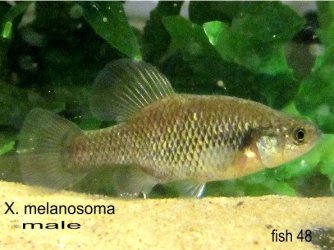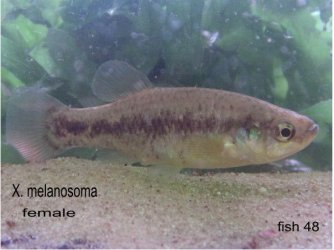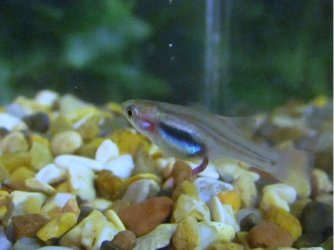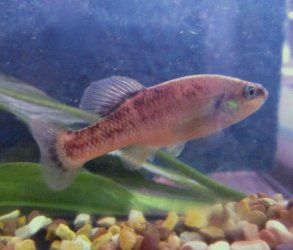British livebearer Association issue 23 june/ 08
Breeding Xenotoca melanosoma By Gary Randall
Xenotoca melanosoma are found throughout the state of Jalisco in Mexico from Rio Tamazulae. Rio Ameca and Rio Grande de Santiago. They attain a maximum size of 80mm (males and females).
I maintained Xenotoca melanosoma many years ago, but eventually decided to pass them to other hobbyists to make room in my fish house for other species of livebearers. Unfortunately they seemed to largely disappear from the hobby.
Around three years ago I came across them in a show and since the person showing them was well known to me I asked him if he would sell me any surplus stocks, unfortunately, the person showing these fish told me that intermittently and had not bred for some time.
Over the next few years. I came across this species occasionally, but nobody had any surplus stocks and everybody keeping them reported the same thing, that they were hard to breed and bred very occasionally. It seemed that nobody had had any success with them.
Last year I got a call from Duncan who had managed to get a couple of pairs from martin tversted in Denmark who was trying to make space in his fish house for other fish. Martin had reported that these fish only bred once or twice a year and Duncan had maintained these fish for a couple of months with no signs of fry. Duncan asked me if I would like a pair but eventually he decided that it would be better if we kept both pairs together so I therefore received both pairs on the understanding that I would give him some fry when/ if I managed to get them to breed.
I maintained both pairs in a relatively large, 30x18x10 (approx 100 liters) aquaria with flower pots as hiding places as the males get aggressive during breeding, usually only resulting in split fins
I maintain the tank at 74 degrees F and I feed them frozen bloodworm and plenty of live foods including white worm and mosquito larvae. About four times per a week I feed them chopped earth worms, they really seem to like this and I feel that earthworms may well be the secret to getting them into prime breeding condition.
I change about 40- 50%of the water every two weeks.
It was not long before the female started to show signs of being gravid and at first I let the females drop into the main tank.
Despite the fact the tank was well planted, the adults killed the young and so I quickly learned that I would have to separate the females into a separate tank in order to have any chance with saving the young.
About a week before the female was due to drop, I moved her into a separate small tank with plastic spawning mats along the sides and back of the tank and some more spawning mats floating on the surface. This method seems to work well, 3”long females regularly drop 30-40 large fry and at birth they are large enough to be fed on grindal worms, daphnia and newly hatched brine shrimp. The fry start to sex out around 3 months old.
Since November the fish have bred almost continually, I have had six broods from the females and at 74 degrees Fahrenheit the gestation period seems to be about 8 weeks.
Gary




